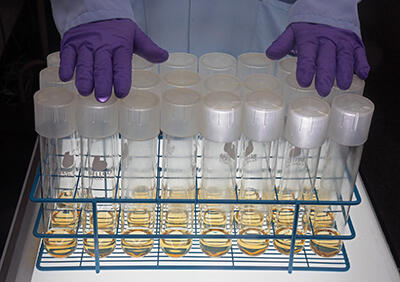Good Laboratory Practice (GLP) is a set of services and principles intended to assure the quality and integrity of non-clinical laboratory studies that support research or marketing permits for products regulated by government agencies. The GLP microbiological laboratories at Southwest Research Institute (SwRI) conduct standard and specialized tests in accordance with the Environmental Protection Agency’s (EPA) Good Laboratory Practice Standards. GLP services ensure quality and integrity of test data submitted to the EPA in support of pesticide products and industrial chemicals under the Federal Insecticide, Fungicide and Rodenticide Act (FIFRA).
Good Laboratory Practice Standards

GLP services include evaluating effectiveness of disinfectants against pathogens.
GLP testing performed at SwRI adheres to guidance under ASTM, AOAC, CLSI, EPA, FDA, MIL, and others, includes:
- GLP-compliant testing of disinfectants for use on environmental surfaces
- Efficacy testing for bactericidal, fungicidal, virucidal, tuberculocidal claims:
- Limited
- Broad-spectrum
- Hospital or healthcare
- For the following formulations:
- Water-soluble powders/liquids
- Spray products
- Towelettes
EPA Pesticide Test Guidelines
- 40 CFR part 160 — FIFRA (GLP 5-Batch Analysis for Pesticide Registration)
- 40 CFR part 792 — TSCA
- EPA-810.2000, General Consideration for Testing Public Health Antimicrobial Pesticides: Guidance for Efficacy Testing
- EPA-810.2100, Sterilants, Sporicides, and Decontaminants: Guidance for Efficacy Testing
- EPA-810.2200, Disinfectants for Use on Environmental Surfaces: Guidance for Efficacy Testing
- MB-05-14, Standard Operating Procedure for AOAC Use Dilution Method of Testing Disinfectants
- MB-06-09, Standard Operating Procedure for Germicidal Spray Products as Disinfectants (GSPT): Testing of Staphylococcus aureus, Pseudomonas aeruginosa, and Salmonella enterica
AAOC Disinfectant Testing Methods
- AOAC 961.02, Germicidal Spray Products as Disinfectants
- AOAC 955.14, Testing Disinfectants Against Salmonella enterica
- AOAC 955.15, Testing Disinfectants Against Staphylococcus aureus
- AOAC 955.17, Fungicidal Activity of Disinfectants (using Trichophyton mentagrophytes)
- AOAC 966.04, Sporicidal Activity Test
- AOAC 2008.05, Efficacy of Liquid Sporicides Against Spores of Bacillus subtilis on A Hard, Nonporous Surface, Quantitative Three-Step Method
ASTM Microbe Testing
- ASTM D3273 Resistance to Growth of Mold on the Surface of Interior Coatings in an Environmental Chamber
- ASTM G21, Determining Resistance of Synthetic Polymer Materials to Fungi
- ASTM E2180, Standard Test Method for Determining the Activity of Incorporated Antimicrobial Agent (s) in Polymeric or Hydrophobic Materials
- ASTM D5590, Standard Test Method for Determining the Resistance of Paint Films and Related Coatings to Fungal Defacement by Accelerated Four-Week Agar Plate Assay
- ASTM E2362, Standard Practice for Evaluation of Pre-saturated or Impregnated Towelettes for Hard Surface Disinfection
- MBEC (Minimum Biofilm Eradication Concentration) assay
Microencapsulation & CGMP Services
Before disinfectant formulations, biocides, prescription drugs, and biomedical devices get to market, they undergo years of pharmaceutical development through research and testing in accordance with the Food and Drug Administration (FDA) standards. Visit Microencapsulation and API Manufacturing & CGMP for more information.
Related Biochemistry Services
Or call Spring Cabiness at +1 210 522 6229.
